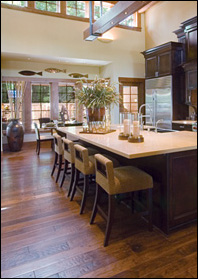Green Flooring Options

Types of Green Flooring
Trying to determine whether a particular product is "green" can be a daunting experience, particularly when it comes to flooring. It is important to work with a retailer and designer who is knowledgeable about green flooring products, because they can help you identify products that are certified as environmentally friendly, assist in ensuring the installation meets environmental standards and provide information about the various green programs that are available. These can often lead to tax benefits and even better financing of your new home or floor.
Each flooring type has green solutions. Products discussed here include carpet, hardwood, linoleum, cork, bamboo, ceramic tile and stone.
Carpet
According to the Carpet and Rug Institute, the carpet industry is minimizing carpet's impact on the environment through the new "3 Rs," which stand for reduce, reuse and recycle. When carpet reaches the end of its long life, it is reused to make new carpet or is recycled into a variety of products. The Green Label and Green Label Plus programs from the Carpet and Rug Institute ensure that customers are purchasing among the lowest-emitting carpet, adhesive, and cushion products on the market.
Green Benefits of Carpet:
- New efforts to minimize environmental impact
- Contains many potential green attributes: carpet fibers, toxics content, dye, VOC emissions, and recycled content
- Certification for safer purchases available
- Many made from recycled PET containers
- Some made from recycled nylon or old car tires
- Wools come from natural, biodegradable materials
Hardwood
Hardwood is a great green flooring choice because of its natural, renewable, and recyclable properties. Not all hardwoods, however, are automatically environmentally friendly. Hardwoods that are harvested without replanting the forest can lead to an adverse impact on the environment. There are a variety of programs that certify which hardwood products are environmentally friendly. The key is to look for the certification label or materials to verify that a product meets green standards. The most common product certification programs are the Forest Stewardship Council (FSC), Scientific Certification Systems (SCS), the American Tree Farm System (ATFS), and the Sustainable Forestry Initiative (SFI) that certify wood from specially-managed forests.
Green Benefits of Hardwood:
- Natural Resource
- Enduring lifecycle
- Renewable
- Recyclable
- Suitable for a "healthy home" environment
- Forests are managed for replanting
Linoleum
Linoleum is not a new product and has always had many environmental benefits. The natural raw materials used to create Linoleum are available in abundance: linseed oil, resin, wood flour, cork flour, ecologically responsible pigments and jute. The plants and trees that supply linoleum's raw materials also contribute to the production of oxygen and the subsequent reduction of carbon dioxide in the atmosphere, thus reducing the amount of greenhouse gasses present in the atmosphere.
Green Benefits of Linoleum:
- Made from all natural materials
- Natural raw materials used are available in abundance
- Raw materials are harvested with little energy use
- Main energy resource is the sun
- Can be recycled
- Can be safely added to landfill refuse sites (natural decomposition)
- Fully biodegradable
- Does not release harmful substances or gases
- Adhesives are available that are 100% solvent free and meet all low VOC requirements
- Does not require chemicals to maintain
- Not adverse to air quality
Cork
Cork represents a special kind of renewable resource because it is a harvested resource (only the bark is harvested from the tree). A law in the 1930's called "The 9 Year Law" was passed to keep cork from being harvested any sooner than every 9 years. The tree has to reach 60 cm in circumference before it can be harvested. It's soft underfoot, offers good sound insulation, and is naturally water-resistant, which makes it a good choice for kitchens and baths. Cork will dent, so pads need to be placed under heavy objects such as appliances.
Green Benefits of Cork:
- Renewable resource
- Recycled product
- Never harvested before it's mature
- Tree is not destroyed or damaged when harvested
- Maximum benefits are achieved by using water-based finishes and adhesives
Bamboo
Bamboo is a rapidly renewing resource that matures in three years. There currently is no bamboo certified as meeting various environmental production or preservation standards, so it is important to try to learn as much as you can about the bamboo you are interested in before purchasing it. Most bamboo is grown in Asia and the impact of transporting it to the United States market should be considered.
Green Benefits of Bamboo:
- Rapidly renewing
- Quickly matures
- Regenerates without replanting
- Requires minimal fertilization or pesticides
Ceramic Tile
Ceramic tile can be viewed as more green in some lights than in others. Its weight uses more fuel for transportation than other products, which leaves its overall green value unclear.
Green Benefits of Ceramic Tile:
- Rarely releases emissions
- Some contain recycled content
- Long lasting and not replaced frequently
- Requires little maintenance
Stone
There is no generally accepted data on the environmental impacts of using stone as a building material. Likely impacts relate to water and energy consumption, yields from raw materials, recyclability, as well as energy used in transportation, processing, and selling the material. Stone includes any quarried rock such as granite, limestone, sandstone, slate, marble or flagstone. Each of these natural stone choices may be glazed or unglazed.
Green Benefits of Stone:
- Natural product
- Enduring lifecycle
- Easy to maintain
- Recyclable
- Quarry and manufacturing use best practices
- Can be reclaimed
Design Tip
Your kitchen flooring is an important element in your green kitchen design, because it needs to match, yet maintain the rigors of daily traffic. Your kitchen flooring should match the tiles, the backsplash, the lighting and the furniture. Whether it's the cabinets, countertop or appliances, everything should merge together with your flooring to create a well-balanced and functional space for you to enjoy for years to come.






